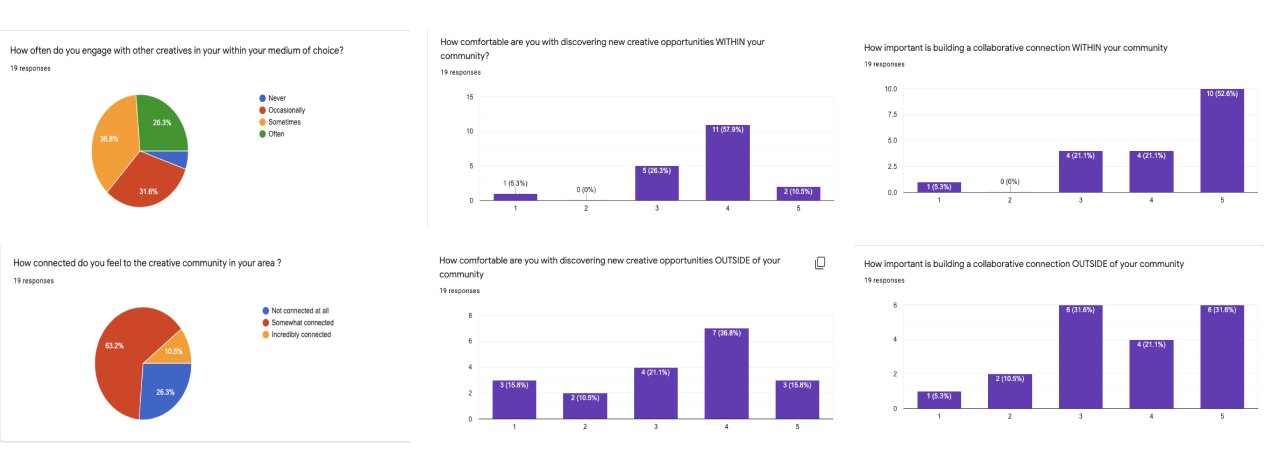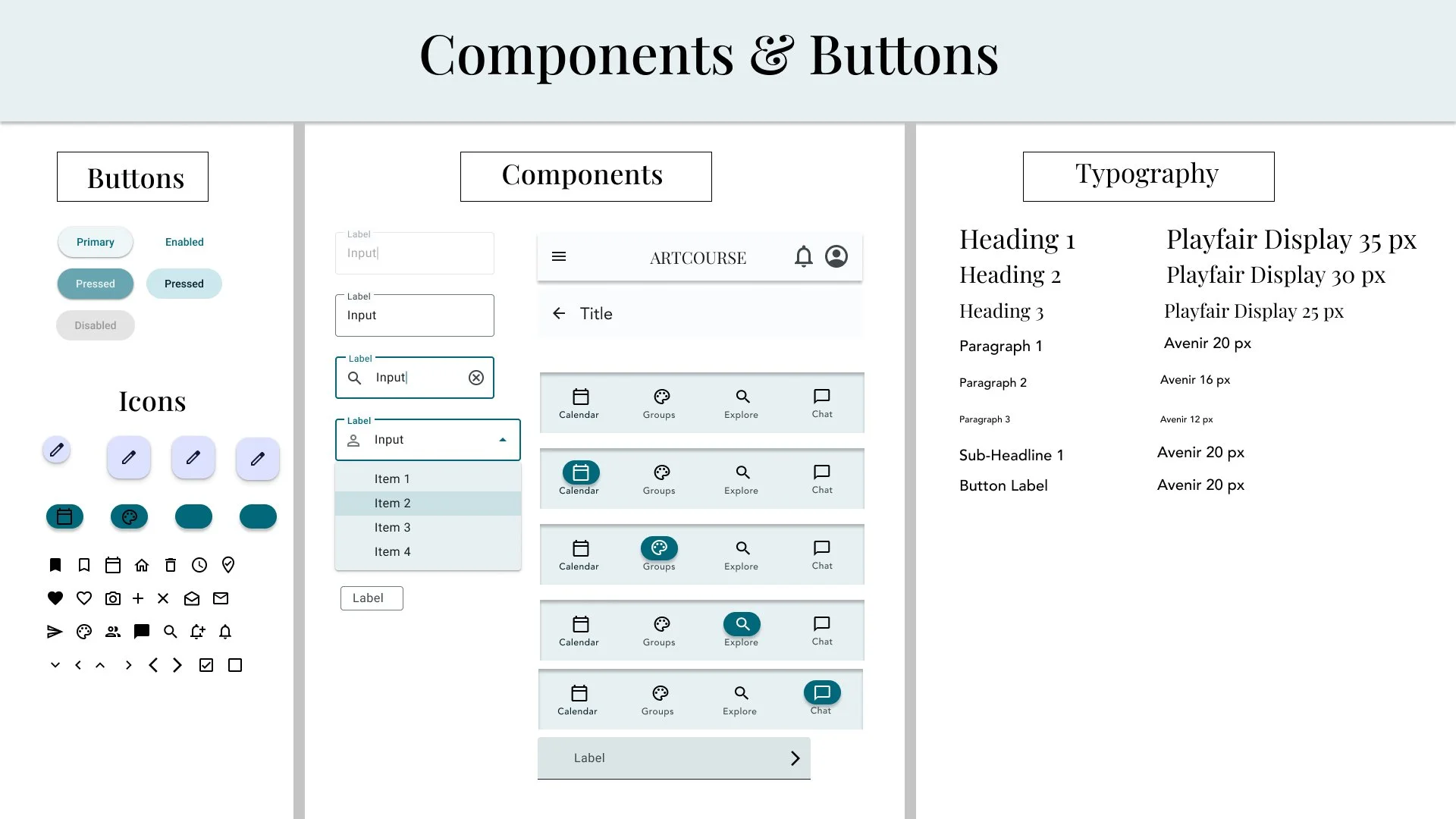
ArtCourse
An connection and inspiration platform tailored specifically to visual artists
-
Problem
Throughout the pandemic, artists have shifted from presenting their work in physical gallery spaces to online platforms. With constant changes in mandate enforcement, artists have needed to find new ways to re engage, discover, and share their work. As a result of this shift, Social media apps have exploded with noisy and excessive content. As it stands, there isn’t a platform that facilitates intentional connections and the discovery of new opportunities specifically tailored to visual artists.
-
Goal
Develop an intuitive, cohesive application for novice to intermediate visual artists that desire a tool to facilitate connection, discovery of new opportunities and the sharing of resources and new work.
-
The Outcome
ArtCourse. An application that allows visual artists to connect with other artists through groups, share their current work and resources, and post creative opportunities and events all in one place.
.
Understanding the Space
“The internet already is what it is. It has already become the central organ of contemporary life. It has already rewired the brains of its users, returning us to a state of primitive hyper awareness and distraction while overloading us with much more sensory input than was ever possible in primitive times. It has already built an ecosystem that runs on exploiting attention and monetizing the self. Even if you avoid the internet completely...you still live in the world that this internet has created...”
Chances are if you are a human living in the 21st century, you’ve encountered this feeling of sensory overload and distraction, and maybe you haven’t even realized it. We live in a digital-first world, and a result of the pandemic has only heightened these changes. This idea of “monetizing the self” has especially struck a chord within the artist community, where work is being viewed primarily through little image squares rather than up close and in person.
Competitive Audit
An artist myself, I’ve experienced the challenging social shift from in person to digital-heavy environments first hand and struggled with this feeling of disconnect within my own practice and have felt my focus shifting from work to becoming a monetary, digital product. Going into this project, I was curious to discover how interested artists were in working with others, and their comfort levels in approaching these opportunities. I also wanted to gauge how they access social media in relation to their process. I began with a competitive audit of what exists in this space, assessing social media and art opportunity boards. With an increasing number of platforms out there, I discovered that there was an opportunity space in creating a platform that facilitates collaboration and intentionally focuses on work and discovery of opportunities for artists.
Survey
Ironically enough, I leveraged my Instagram community and sent out a request to creatives within my network to complete a brief survey. Through this process, I received 20 responses from people who identified themselves as creative with practices ranging from textile work, painting, music, and theater. This survey included questions that helped me gauge where people find their creativity, and the importance of collaboration and comfort levels in accomplishing both.
Key Findings:
Users value connection within their community
Users value collaboration both inside and outside of their community but vary in comfort levels
Insight: The term creative is an all encompassing word that provided a lot of insight into the values of those who make to express themselves. As much as I wanted to include every element of creativity, I needed to simplify my user group to a more specific creative circle to begin exploring other opportunities.
Directed Storytelling
I originally had three zoom interviews scheduled to discover the needs of artists. Interested in learning about a variety of creative’s desires and the community landscape, I interviewed an art history professor, freelance musician, and a full time painter. I wanted to discover where they found their inspiration and how they interacted with other artists within and outside of their communities. Through these interviews, it became apparent that in order to further their practice, artists valued community and relationships. The importance of cultivating and sharing connections, drawing inspiration by learning and conversing with others was impactful to their own creative growth.
In Person Observation
Through my last scheduled interview, it was recommended to me that I reach out to another artist. A loose connection from the artist community, I decided to contact them and we set up a time to chat. To only further back up the importance of community among artists, this interview led me to an invitation to an “Artists in Conversation Group”, a small gathering of creatives that encourage, support, and provide feedback on what projects they’re currently working on. Receiving feedback puts the artist in an incredibly vulnerable place, and it’s important to have a safe, trusting, environment to go to for support. Most people in attendance were new to the area and desired an artist community, expressing value in both digital and in-person frameworks. My observations validated the emphasis on community and making it accessible to artists.
Interpreting Findings
Mapping out the Journey
After synthesizing information collected from my variety of interviews, I proceeded to brainstorm potential ways to satisfy this opportunity space. To demonstrate the journey and key task flows a user would take, I created personas, journey maps and user flows based on my directed storytelling interviews. The culmination of user needs as well as mapping out opportunity areas of what currently exists helped narrow down key features that were necessary for the design.
Key Opportunity areas included:
Efficiency in discovering opportunities
Organization behind coordinating meet-ups
Information Architecture & Wireframes
Low-fidelity wireframes created in Figma
I developed low fidelity wireframes based on the opportunity areas I uncovered from the user journey maps. They were then presented through usability testing to two potential users through zoom.
These key features included:
Opportunities Board-Place where users can easily access and filter jobs, grants,
Group Features
Filterable Feed
Public and Private profiles
Critique Board Option
Key Insights:
Users understood the intention of the website based off the frames shown to them
Users felt the feed was too busy and hard to focus on
Users questioned the critique element of the application
Style Guide
As an additional asset to this project, I developed a design system using components from Material Design. This process includes creating schemes based on Dynamic color systems for optimal accessibility and consistency throughout the application. Intention behind using a softer color scheme, while also demonstrating contrast was ideal for complimenting the variety of colorful, dynamic posts submitted by the users.
High Fidelity Wireframes
Once I had a design system in place, I designed hi-fidelity wireframes with the improvements and suggestions provided through my second round of user interviews. This included cleaning up the feed page, with the original screens feeling “a bit too busy” from the users. Users did not like the idea of a critique board, because it could potentially be problematic with the concept being incredibly personal and at risk for public scrutiny. I adapted those insights into a simple chat feature, paired with open group options so users can share and receive feedback in a more intentional way with those that they feel safe with.
Conclusion and Next Steps
Inspiration for this project sparked back in the springtime of 2020, when lockdown laid its initial global shock. Longings of connection and creative inspiration loomed, and I sought out to create a way to engage and stay inspired during an emotionally devastating and confusing time. The result was a collaborative mail art project, which can be viewed here. Through the process of the ArtCourse project, ideas pivoted from strictly collaboration, and critique, to a more holistic approach tailored specifically to visual artists in order to satisfy their desires of connection, discovery, and sharing. It enlightened me to uncover the ultimate importance community plays within the artists network and how it can play out in a multitude of forms, both physically and virtually.
There are still several visions behind the ArtCourse app that have yet to be built out. These features include a “To-Do” list feature complete with calendar, skill share and resources section and small business tips for those looking to build out their own business. All of this would require additional usability testing and kano analysis to uncover the desirability of these idealized features.











